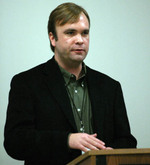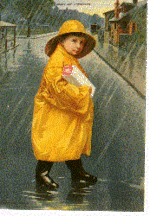Following is the essay you can designate as Volume 10, Number 31 of
This Week’s Clue, based on the e-mail newsletter I have produced since
March, 1997. It would be the issue of August 6.
Enjoy.
In my discussions of generational change over the last year I have mainly emphasized its political dimension.
A new political thesis, new myths and new values meant to control power, emerges just once a generation in America. Each shift is preceded by a crisis period, in which the old assumptions are shown to be irrelevant to the new challenges. The result of the crisis is a political re-alignment which holds until the people who created it age and die.
Currently, we are leaving the Nixon Thesis of Conflict and, I have asserted, heading toward a generation which follows the Internet Values of transparency, consensus and openness. These values are rising because they have been shown to work in the lives of the rising generation. They address the problems of today in ways the old assumptions can’t fathom. They ask the right questions, and offer guides for finding answers.
I have also described how each new generation creates a new dominant media. In the Nixon Era, Cable TV and talk radio have been the dominant media. It’s where we went to learn what we called truth, the truth we matched to our myths and values in making political choices.
Most of us assume this has always been true, and for most of us TV has been dominant for as long as we can remember.
But early in the 1960s TV was considered ancillary — radio, movies, and mass market newspapers were the chief media of persuasion. TV was considered to be mainly entertainment. While today’s historians go back to events from the 1950s, like the Army-McCarthy hearings or the Checker’s Speech, and claim that TV has been dominant since its creation, that’s just not how people back then saw things. That’s not how things were.
That’s not how things are going to be, either. While TV executives continue their relentless drumbeat of right-wing talk, with just a few dissenting voices on cable like The Daily Show or Keith Olbermann, a new dominant medium is emerging. It’s the one you’re using right now.
The Internet can be TV, when you’re using a YouTube window. But it can also be radio. It can be a newspaper. It can be a telephone. It can be a library, a road map, or a letter from a friend. Given its interactive nature, it’s a great deal more as well. You can zip from here to Pakistan in a moment via hyperlink, then hit the back button and zip right back. All this enables Internet media to earn credibility, through the testing of the audience, in ways the old media just can’t match.
And now, of course, the Internet is getting TV-like numbers. Every day, more people use Dailykos.com than watch any TV cable news show — more than O’Reilly, more than Blitzer, more than Olbermann. The kos site’s daily traffic of almost 750,000 daily site visits dwarfs cable, where most of the opinion-molding TV does these days goes on.
And of course Kos is not alone. It’s no longer unusual for a scaled site (not this one) to get 100,000 site visits in a day. Even a blog site like Atrios (right), Firedoglake or TalkingPointsMemo can draw a number no cable executive would sneer at (especially when RSS subscriptions are added) — not with Glenn Beck consistently drawing fewer visitors on the TeeVee.
None of this is the point of today’s Clue. It’s background to the point.
The point is that changing politics and changing media also bring with them changing business models. It’s the creation of new, viable business models which is the first herald of a generational change.
- Mass production and nationwide markets were the heralds for the political upheavals of the 1890s. Nabisco was born at this time, basing its success on a low-priced, mass-produced biscuit which could be transported anywhere, and sold in the same way everywhere, resulting in a single national market.
- Mass media were the heralds for the political upheavals of the 1930s. RCA radios, and the RCA radio networks, represented one leg of this change. MGM, and the mass market for movies, represented the other. In both cases, national stars, national advertisements and universally-recognized images became the rule. The modern idea of a star was born.
Niche audiences were the heralds of the political change we saw in the 1960s. Radio and, thanks to the Space Race, satellites meant that dozens of choices in national media were now possible. This business model, whether used by print media, radio, or cable, is now what we assume to be true.
The new Internet business models are open source and The Long Tail.
- Open source is a new relationship between provider and customer, designed for an economics of abundance. You get the software free, you can even see the code. It’s the services built on top of the software, whether support, or transaction services, or file deliveries, that drive money.
The mass market audience is no more. Even the niche collected audience is being transformed. Every Internet user is an audience of one, and the attention economy is all about getting a piece of that individual’s mental traffic. The Long Tail means that the shelves are filled, and anything can be sold off those shelves at a profit. The trick is to be found.
Because these business models are so new, because the Internet as a mass medium is so new, most analysts today are completely at sea. Just as they were at sea 40 years ago as the mass market atomized into niches, and just as they were at sea 40 years before that as the mass media was born. It was only the people who were working within those rising media — DJs and cable executives in the late 1960s, radio programmers and movie producers in the early 1930s — who had so much as a Clue as to what was going on.
This, not some grand conspiracy, is the reason why today’s media doesn’t seem to "get it." It’s not just that they are wedded to the political myths and values they grew up with. It’s not that they’re corrupt. It’s because they are part of an ebbing business tide.
Since you’re here, of course, and not there, you’re part of the rising tide. Anyone who spends most of their media time on the Internet, no matter what their older political assumptions, is closer to divining the future than any talking head in any studio in the land.
It’s only on the frontier that you’ll find tomorrow.















